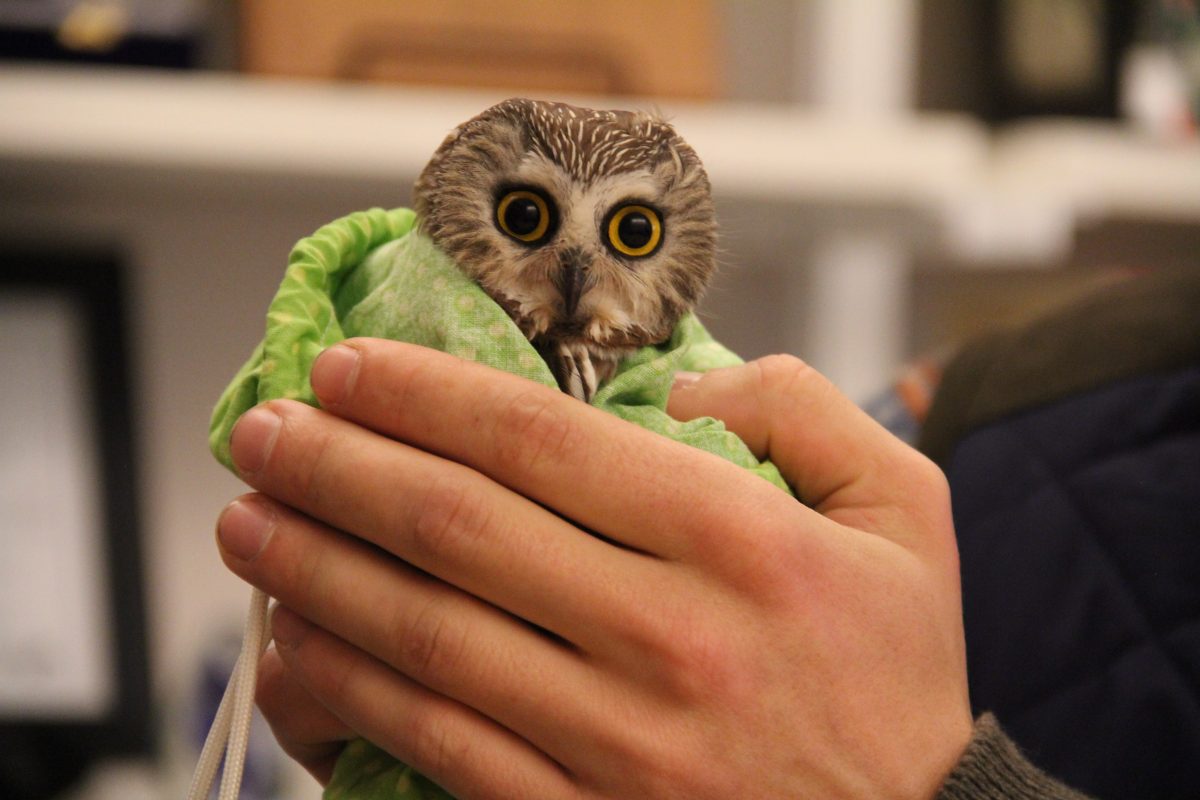A tiny Northern Saw-whet Owl sprung off of Naturalist Tyler Christensen’s hand and vanished into the darkness, silently slicing through the night air. Their stealthy flight allows these nocturnal owls to more easily catch mice and other small prey while wintering in New Jersey and farther south as they migrate from their breeding grounds in southern Canada and northern United States.
Christensen is the director of the Wild Bird Research Group, Inc., and the nonprofit is in its fifth year of banding the Saw-whet Owls at the Watershed Reserve. For the past month, he has shared his expertise and enthusiasm for these rarely seen creatures during educational sessions at The Watershed Center.
As a group listened attentively in the Watershed Center, Christensen and his team pulled the diminutive owls from satchels, holding securely onto their feet. The Saw-whet’s saucer-shaped face directs sound to their ears, helping the owls hear the rustling sounds of their prey. Their enormous eyes help them hunt from perches in the trees and shrubs.
In what is shaping up to be a banner year, Christensen and his team have banded 271 of these nocturnal creatures so far. One owl he banded was recaptured at a Smithsonian station in Maryland just six days later, showing how far it had travelled.
“We are catching more owls than ever before,” Christensen said. “On our busiest night this year we caught 64 owls. While these are not a threatened or endangered species, they do seem to be declining, and population monitoring through bird banding helps us figure out why.”
Christensen also said the fluctuation in Saw-whet numbers is largely due to the amount of prey available, which in turn is driven by the amount of resources available for the prey to eat.

Tyler Christensen
Christensen attached the bird band that is etched with a unique number, akin to the “bird’s social security number,” and explained how the data is submitted to the federal Bird Banding Laboratory, which allows banding stations across North America to share data. He also weighed, measured and softly blew on the feathers to visually gauge the owl’s fat storage. Next, he spread a bird’s wing and shone a black light on the underside to determine its age from the molting pattern.
Saw-whet Owls, which weigh about as much as a deck of playing cards and are the size of a soda can, reach full size in one month and begin hunting by themselves after two months. They typically live for about 3-5 years, though one banded Saw-whet Owl recorded in New York last week was at least nine years of age.
During the fall and winter, the males tend to stay close to their breeding grounds with the females flying south and the younger females migrating the greatest distances. The females lay clutches of three to seven eggs and, in bountiful years with an abundance of food, may have two broods.
“If the females and young are well-fed, a greater proportion of owlets will survive,” Christensen said.
Heide and Joe Sagliani traveled from Washington, N.J., for a recent banding session.
“Joe and I learned so much about their migration patterns. We just love owls and do our own bird rescues,” Heide said. “What is so amazing is that the owls aren’t injured when they are caught.”
Added her husband, “I think a bat makes more noise than those owls do when they fly away. They are such amazing, calm, and docile creatures.”
Visitors Meg and Karl Horster came to the banding demonstration from Warren, N.J., with their owl-enthusiast son, Oliver. They joined the group visiting the mist nets and marveled at everything they learned about the owl’s migration, ecology, adaptations and behavior.
“I just wanted to let you know how much we loved the owl banding program,” Meg wrote in an email a few days later. “Our son is still talking about it, it surely has left an imprint. This is the hope with programs such as this, to feed that curiosity and stoke that insatiable fire. What an experience for my family.”
The Watershed Institute (formerly the Stony Brook-Millstone Watershed Association) is dedicated to keeping Central New Jersey’s water clean, safe and healthy. Founded in 1949, The Watershed Institute protects and restores water and the environment through conservation, advocacy, science and education.




